Fujifilm GFX 50S Disrupts the Medium Format (and 35mm) Marketplace
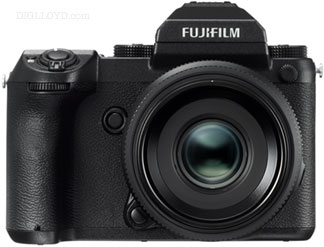
Get Hasselblad X1D and Fujifilm GF lenses at B&H Photo. See my Fujifilm GFX wish list, to be fleshed out as the product line becomes available for ordering.
B&H does not yet list a price for the Fujifilm GFX. I’ll post an update when available—please order using my links at B&H when buying—NOT email notification from B&H—so I get credit.
Fujifilm has a microsite for the Fujifilm GFX.
UPDATE: my my Jan 11 2017 notes and related Fujifilm GFX notes.
See also the Fujifilm GF lens lineup.
The nascent medium format with one entrant is transforming into a category: with the Hasselblad X1D due to arrive within a week for testing, the Fujifilm GFX 50 is now on the horizon. Can Sony be far behind?
- 51.4MP 43.8 x 32.9mm CMOS Sensor, X-Processor Pro Image Processor
- Removable Electronic Viewfinder
- ISO 100-12800
- Focal Plane Shutter, Up to 1/4000 sec. [diglloyd: is there an EFC shutter?]
- Top Settings LCD Monitor
- Multi Aspect Ratio Shooting
- Weather-Sealed Construction and Tethered Shooting Support
Target price for the GFX 50S with 63mm standard prime is said to be well under $10,000 with the camera to be available in early 2017, which should give Hasselblad time to work out any kinks in the Hasselblad X1D. Personally, I’d place my bet on Fujifilm, with its deep experience in mirrorless technology, and the aggressive lens line rollout (see below).
The Fujifilm GFX 50S sports an electronic first curtain EFC shutter as well as a focal plane shutter. The X1D has only leaf shutter lenses and is thus useless for adapting to systems like the Cambo ACTUS Mini View Camera.
Regular readers know that I have been quite unhappy about the fractal-like artifacts of the Fujifilm X series along with the APS-C sensor and relatively low resolution (well, and the operating quirks also). But Fujifilm has some terrific technology, and brought together on a 50-megapixel conventional sensor, the appeal will be great. Still, I wonder how much the ardor of the fan base will cool when the pricing is considered, seemingly around 3X to 4X the price for a one-lens Fujifilm X system.
The 51.4-megapixel sensor in the Fujifilm GFX 50S measures 43.8 x 32.9mm giving it a 4:3 aspect ratio, same as the Hasselblad X1D. The sensor is apparently a design as per Fujifilm specifications. Since there is no mention of the solution-in-search-of-a-problem X-Trans technology, I am hopeful for conventional ultra-high grade medium-format image quality.
One missing thing that would have been awesome: in body image stabilization with Pentax K1 Super High Res pixel shift mode . One can’t have everything; the technology to stabilize a medium format sensor may be too troublesome.
Given the lens lineup generously-sized 50-megapixel sensor, I’m having a hard time figuring why I would ever want to bother again with Nikon or Canon for landscape shooting*. With Live View and an EVF and the full range of focal lengths I commonly shoot (well, close enough anyway), The Fujifilm GFX resets the game on not just landscape photography, but still-life, macro, heck even street shooting if the GFX camera performs anything nearly as good as the Fujifilm X-T2. If the GFX has an EFC shutter, it also means that adapting the camera to many platforms (e.g., Cambo Mini View Camera) and to Nikon and perhaps even Canon lenses should be possible (albeit with less than full image circle coverage), further enhancing its value. If the Leica S system had been a dubious value with its grossly over priced camera body with its godawful autofocus, the Fujifilm GFX is the nail in the coffin for it and its overpriced and under-featured ilk.
I’m a bit puzzled by 14°F / -10°C rating. That is not very cold, indeed it is 14°F warmer than my Thanksgiving camp-out and when I was shooting images in the 0°F to 15°F range with the Canon 5DS R and Nikon D810. Presumably it still works at 0°F, but with reduced battery life.
*That is, for my own personal purposes—I’ll continue to review 35mm gear just as always.

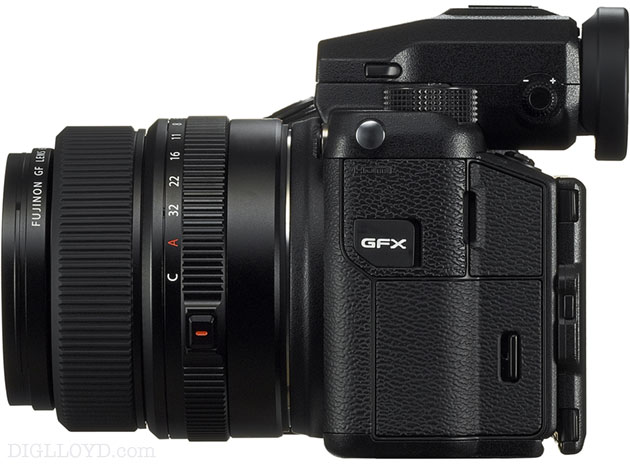
Fujifilm GF lens lineup: 5 primes and zoom, optimized for mirrorless
One wonders whether Leica S lenses might be adapted? The GFX has a flange focal distance of only 26.7mm, so there appears to be ample room for a lens adapter for Leica S, including a tripod collar. Ditto for adapting Zeiss Otus lenses, which won’t cover the frame, but will go somewhat larger than 36 X 24mm.
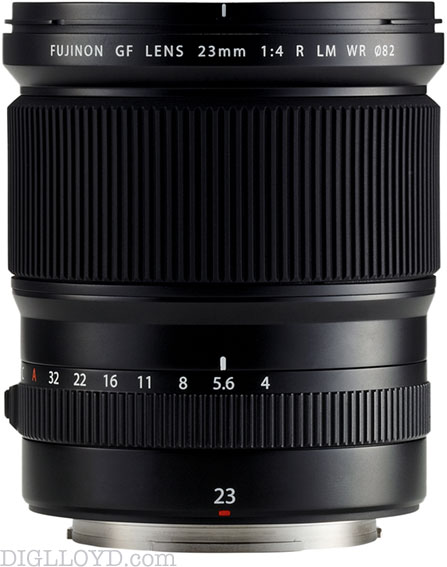
Lenses use the new Fujifilm GF mount. An aggressively fast rollout schedule that by mid 2017 promises a full-range lens kit is impressive indeed, showing that major engineering resources were deployed. This is not a tentative dip of toes into the water; this is a major launch unprecedented in medium format (or any format), by the range and variety of the lens line to appear in less than a year after announcing.
Other medium format companies should look at this as both validation of the medium format market (maybe, since mirrorless MF is a total remake of the market), and thus an existential crisis for the same reasons that DSLR market has been assaulted by 35mm mirrorless cameras. When and if Sony enters the MF market, it will exert huge price pressure on existing conventional MF players: Pentax failed because nothing really new was offered and most of the lens line is mediocre. Fujifilm is all new (mirrorless) with all-new lens designs likely to 'rock'.
Is medium format the new full frame?
The 51.4-megapixel sensor measures 43.8 x 32.9mm, so multiply by 0.82 for the equivalent focal length for the equivalent horizontal field of view in full-frame 35mm, ditto for the f-stop (or divide by 1.22). See also Format-Equivalent Depth of Field and F-Stop. However, the sensor is a 4:3 aspect ratio, so there is no exact equivalence for a 3:2 aspect ratio; the horizontal or vertical or diagonal length produce slightly different equivalence numbers.
- GF 23mm f/4 R LM WR [FF equiv ~19mm f/3.2], in 2017
- GF 32-64mm f/4 R LM WR [FF equiv ~26-52mm f/3.2]
- GF 45mm f/2.8 WR [FF equiv ~37mm f/2.3], in late 2017
- GF 63mm f/2.8 R WR [FF equiv ~52mm f/2.3]
- GF 110mm f/2, in mid 2017 [FF equiv ~90mm f/1.6]
- GF 120mm f/4 Macro [FF equiv ~98mm f/3.2]
Of particular note is the ~19mm equivalent. This is exciting as there are few extreme wide angle lenses for medium format.
For the most part, Fujifilm has chosen wisely to use relatively modest maximum apertures, typical in medium format lenses in order to keep size and weight down, and performance up. The notable exception is the 110mm f/2 which offers the brightest aperture of any medium format lens out there (the Leica 100mm f/2 Summicron-S ASPH is just as fast, but a slightly shorter focal length).
If the price point of this system is aggressive enough, might it generate enough volume to entice Zeiss to create Otus grade lenses for the system? Zeiss did commit to the Touit system, but its costs were amortized across both the Sony and Fujifilm X systems. My guess is that the Touit lineup was a net loss and the Zeiss will hesitate to support a low-volume system, even a pro system like the Fujifilm GFX.
Fujifilm GF Lenses
The lenses look to have professional-grade build and are dust and weather sealed.
This is an astonishing range to be rolled out within a year. Fujifilm is clearly going after the medium format market with a major investment.



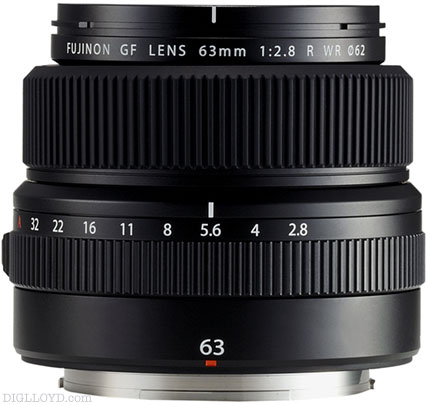
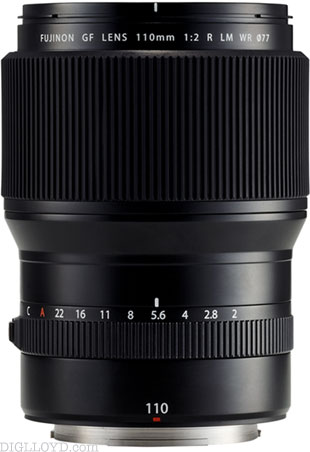

Fujifilm press release
As per Fujifilm.
FUJIFILM ANNOUNCES DEVELOPMENT OF NEW MEDIUM FORMAT “GFX” MIRRORLESS CAMERA SYSTEM
FUJIFILM GFX 50S will give professional photographers the most extraordinary image quality in the history of Fujifilm
Valhalla, N.Y., September 19, 2016 – In response to unprecedented interest from professional photographers, FUJIFILM North America Corporation today announces the development of the new medium format FUJIFILM GFX mirrorless digital camera system that will deliver unmatched and exceptional image quality. The innovative GFX system will reach a new Fujifilm photographic standard, and support its ongoing commitment to providing the total imaging solution for photographers.
Photographic Excellence and Innovation
Over the course of its proud history that extends over 80 years, Fujifilm has developed
and manufactured photographic films with advanced image resolution, outstanding
color reproduction and tonal qualities to meet the needs of professional photographers as well as photo enthusiasts. Fujifilm offers an extensive range of professional cameras under the consistent philosophy that “a camera is a tool for capturing your creative vision,” and high quality FUJINON lenses are an indispensable part of that commitment. All of the technologies and expertise of Fujifilm have been amassed to develop the new GFX, which uses a medium-format sensor to achieve the highest level of image quality and a completely new type of mirrorless system, and its companion FUJINON GF lenses.FUJIFILM GFX 50S
The FUJIFILM GFX 50S mirrorless digital camera will feature the new FUJIFILM G Format 43.8 x 32.9mm sensor with an astonishing 51.4MP resolution and six FUJINON GF Lenses that will be introduced sequentially in early 2017.
Professional-use Mirrorless Camera System
As a long-term manufacturer of photographic films and medium-format film cameras,
Fujifilm was always aware of the impact that different formats have on
photographic expressions. Using a larger format gives an ultimate enhancement to a
camera’s ability to capture “texture,” “depth” and “dimension,” which cannot be attained even by substantially increasing the sensor’s pixel count.Since the launch of the X Series, an increasing number of professional photographers
and photo enthusiasts expressed their desire to achieve the ultimate photographic expression with the X Series’ signature color reproduction. The GFX camera system with the G Format is Fujifilm’s response to their requests.The FUJIFILM GFX 50S 51.4MP sensor can be adapted to various aspect
ratios, including 4:3 (default), 3:2, 1:1, 4:5, 6:7 and 6:17, which were available in large and medium format film cameras. The GFX 50S will use the high-performance “X-Processor Pro” imaging processor to provide Fujifilm’s outstanding color and tone reproduction at an extremely high level. The result is the ultimate capability in photographic expressions that only Fujifilm can deliver thanks to its extensive knowledge in film and medium-format cameras.Revolutionary Design Concept
The FUJIFILM GFX 50S revolutionizes the concept of medium-format cameras, and compared to conventional medium-format digital SLR cameras, the GFX is lighter in weight, and achieves a far more compact form factor. With regards to functionality, the camera follows in the footsteps of the X Series by featuring numerous physical buttons and dials, and is designed with an ergonomic grip, shaped carefully and optimized for the camera body and lenses.
The FUJIFILM GFX 50S will feature a detachable electronic viewfinder, which users can remove when using an external monitor or wanting to make the system even lighter. In addition, an optional adapter makes it possible to fit the EVF at any angle, giving greater freedom in the choice of shooting angle. Other optional accessories that will be available at launch include the Vertical Battery Grip, which enhances functionality when shooting in the portrait orientation. The camera also supports tethered shooting, which has become an essential part of the professional photographers’ workflow, and will be compatible with various RAW conversion application software.
 Fujifilm GF 110mm f/2 R LM WR
Fujifilm GF 110mm f/2 R LM WRNewly-developed FUJINON Lenses
The FUJIFILM GFX 50S will use newly-designed FUJINON lenses with a new lens mount for highest performance and image quality.
A new lineup of FUJINON GF lenses, designed specifically for the GFX, supports the
new G Mount. Taking advantage of the mirrorless system’s structure, the G Mount has
the short flange back distance of just 26.7mm to shorten the back focus distance as
much as possible. This prevents vignetting to achieve edge-to-edge sharpness of the
world’s highest level.The initial lineup will include the following six FUJINON lenses (“equivalent to” is relative to 35mm format):
- GF 32-64mm F4 R LM WR (equivalent to 25-51mm)
- GF 23mm F4 R LM WR (equiv to 18mm )
- GF 45mm F2.8 R WR (equiv to 35mm )
- GF 63mm F2.8 R WR (equiv to 50mm )
- GF 110mm F2 R LM WR (equiv to 87mm )
- GF 120mm F4 Macro R LM OIS WR (equiv to 95mm)
Additional Features
The new FUJINON lenses will feature an aperture ring, a popular feature in the X Series, and have a new C (Command) Position on the ring to enable aperture adjustments with the Command Dial on the camera body. Each lens will be dust and weather resistant, built to withstand operation at temperatures as low as 14 degrees Fahrenheit / -10 degrees Celsius allowing photographers to take them outdoors with confidence in challenging weather conditions.
FUJIFILM GFX 50S Key Features:
51.4MP Medium Format 43.8 x 32.9mm sensor for superior sharpness and
image quality for all professional photographersCan be adapted to various aspect ratios, including 4:3 (default), 3:2, 1:1, 4:5, 6:7 and 6:17
FUJIFILM “G Mount” with short flange back distance of just 26.7mm“X-Processor Pro” imaging processor
Detachable electronic viewfinder
Weather and dust resistant; operates as low as 14 degrees Fahrenheit \ -10 degrees Celsius
Availability and Pricing
The new FUJIFILM GFX system will be available in early 2017 in the U.S. with pricing to be announced at a later date.
Michael J writes:
One question I have that I don’t see answered in Fuji’s official press release is if the camera will have it’s own internal shutter or depend on lenses with internal shutters as the Hasselblad X1D does. Here’s a response from Richard Lotte of Cambo about the Hasselblad being compatible with the Cambo ACTUS Mini View Camera:
"Unlike other mirrorless cameras on the market, the X1D has no built-in shutter. An adaptation to the Actus would only make sense, if the camera can be triggered by a ‘3rd party shutter’ like a Copal in a Rodenstock lens. It is up to Hasselblad whether or not they are going to support this.”
Hopefully the Fuji will not have the same restriction.
DIGLLOYD: I don’t know, but I have sent an inquiry to the PR agency (I don’t have any direct Fujifilm contacts unfortunately).































